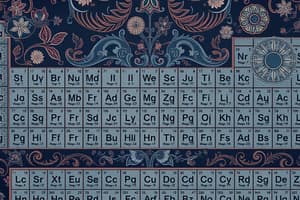Podcast
Questions and Answers
How did chemists begin the process of organizing elements?
How did chemists begin the process of organizing elements?
In 1829, J.W. Dobereiner organized the elements into groups of triads, 3 elements with similar chemical properties.
What property did Mendeleev use to organize his periodic table?
What property did Mendeleev use to organize his periodic table?
Mendeleev arranged the elements according to increasing atomic mass.
How are elements arranged in the modern periodic table?
How are elements arranged in the modern periodic table?
In the modern periodic table, elements are arranged according to increasing atomic number.
Name the three broad classes of elements.
Name the three broad classes of elements.
Which of these sets of elements have similar physical and chemical properties?
Which of these sets of elements have similar physical and chemical properties?
Identify each element as a metal, metalloid, or nonmetal.
Identify each element as a metal, metalloid, or nonmetal.
Name two elements that have properties similar to those of the element sodium.
Name two elements that have properties similar to those of the element sodium.
Write the electron configuration of carbon.
Write the electron configuration of carbon.
What elements end with the following configuration: ns2 np1?
What elements end with the following configuration: ns2 np1?
What information can be included in a periodic table?
What information can be included in a periodic table?
Into what four classes can elements be sorted based on their electron configurations?
Into what four classes can elements be sorted based on their electron configurations?
Why do the elements potassium and sodium have similar chemical properties?
Why do the elements potassium and sodium have similar chemical properties?
Is this electron configuration a representative element, transition metal, or noble gas?
Is this electron configuration a representative element, transition metal, or noble gas?
Which of the following are transition metals: Cu, Sr, Cd, Au, Al, Ge, Co?
Which of the following are transition metals: Cu, Sr, Cd, Au, Al, Ge, Co?
Flashcards are hidden until you start studying
Study Notes
Early Organization of Elements
- J.W. Dobereiner organized elements into triads in 1829, grouping three elements with similar chemical properties.
- Noted that one element in each triad had properties that were intermediate between the other two.
- This triadic system had limitations as it could not incorporate newly discovered elements.
Mendeleev's Periodic Table
- Mendeleev arranged elements by increasing atomic mass, establishing a method for classification.
Modern Periodic Table Arrangement
- Elements in the modern periodic table are organized by increasing atomic number instead of atomic mass.
Classes of Elements
- The three primary classes of elements are metals, nonmetals, and metalloids.
Elements with Similar Properties
- Strontium, magnesium, calcium, and beryllium exhibit similar physical and chemical properties.
Identification of Elements
- Gold is classified as a metal.
- Silicon is categorized as a metalloid.
- Sulfur is identified as a nonmetal.
- Barium is also categorized as a metal.
Similar Properties Across Elements
- Lithium and potassium share properties with sodium, as they are in the same group (alkali metals).
Electron Configuration
- The electron configuration of carbon is written as 1s² 2s² 2p² or [He] 2s² 2p².
Elements with Specific Electron Configurations
- Elements that end with the configuration ns² np¹ include boron, aluminum, gallium, indium, and thallium.
Information in the Periodic Table
- The periodic table organizes elements by families, revealing similarities and periodic trends.
- Contains chemical symbols, atomic numbers, mass numbers, and sometimes electron distribution.
- Displays the state of matter for each element at standard conditions.
- Features a line separating metals from nonmetals, with metalloids positioned in between.
- Color coding may be used to differentiate groups of elements.
Classification Based on Electron Configurations
- Four classes based on electron configurations: noble gases, representative elements, transition metals, and inner transition metals.
Similar Chemical Properties
- Potassium and sodium have similar chemical properties due to both having one valence electron.
Noble Gases
- Krypton serves as an example of a noble gas based on its specific electron configuration.
Transition Metals Identification
- Transition metals are located in the d block. From the provided list, copper (Cu), cadmium (Cd), gold (Au), and cobalt (Co) are identified as transition metals.
Studying That Suits You
Use AI to generate personalized quizzes and flashcards to suit your learning preferences.




